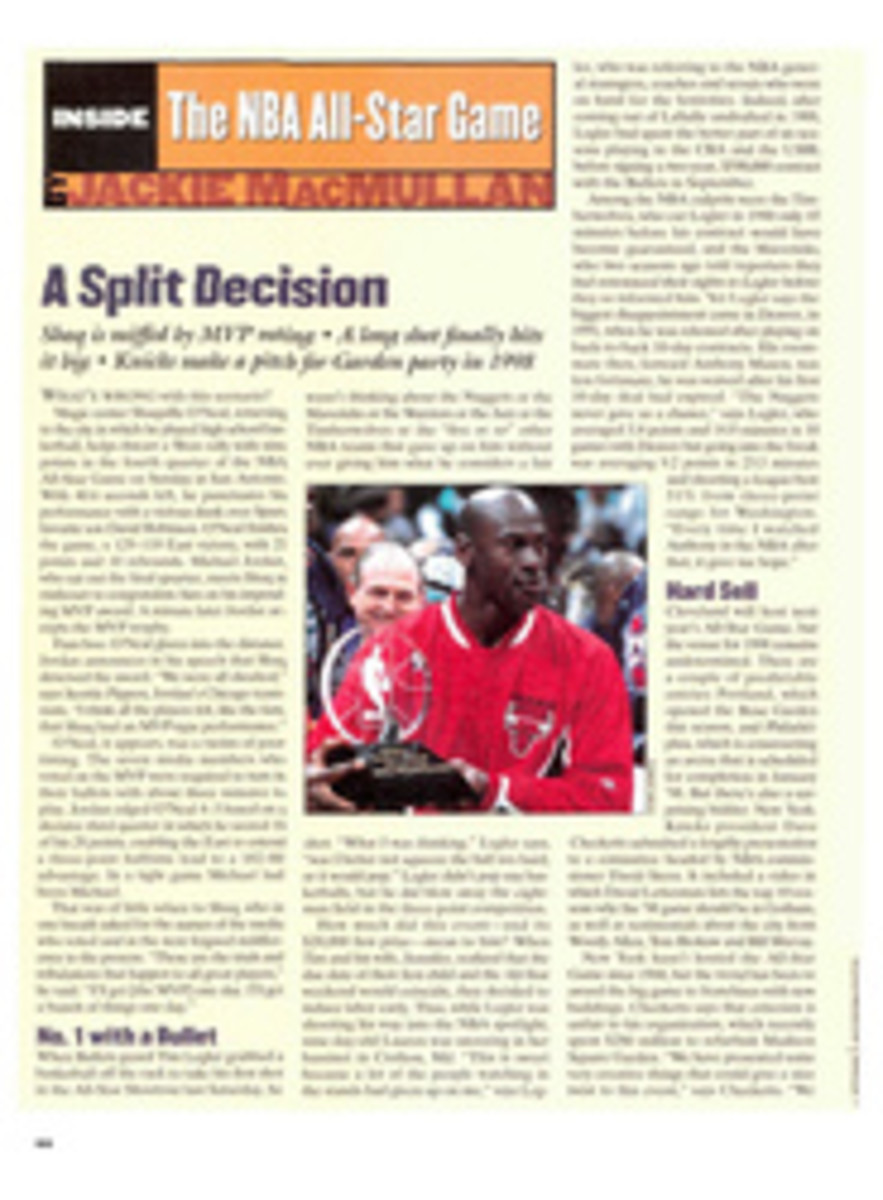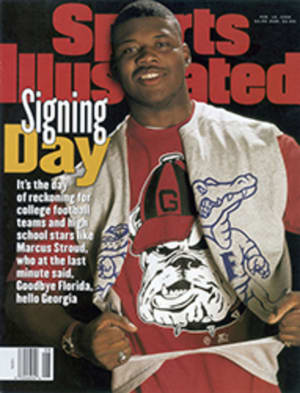
MAN ON A MISSION RUSS CONWAY'S INVESTIGATIVE WORK MAY BRING DOWN A HOCKEY POWER BROKER
This is only a guess--not the documented-to-death reporting Russ
Conway does--but the odds are excellent that Conway was the only
Pulitzer Prize runner-up who covered a high school football game
last Thanksgiving.
Conway is a small-town guy working on a small-town newspaper,
the Eagle-Tribune in Lawrence, Mass., but he has made a big-time
impact on pro hockey. Besides covering Boston Bruins home games,
checking out the local preps and doing the things any sports
editor of a 55,000-circulation newspaper must, Conway has pulled
off some of the most compelling investigative reporting in
sports journalism. His work--one of three finalists for the 1992
Pulitzer for beat reporting--is on the brink of bringing down
Alan Eagleson, founder and former president of the NHL Players
Association and one of the most powerful men in hockey.
Eagleson was much more than just a union boss in the 1970s and
1980s. He was the patron of the 1972 Super Series with the
Soviet Union, a player agent, the organizer of Canada Cup
tournaments and a friend to prime ministers. He fed colorful
quotes to the media, which benignly called him "a man of many
hats."
Eagleson turned out to be choice game for Conway, a man who can
read financial statements like a CPA and work a telephone better
than a teenager. Bit by juicy bit, revelation by startling
revelation, Conway exposed Eagleson's duplicitous dealings
beneath those many hats.
Here are just a few of the allegations Conway has brought to
light in the Eagle-Tribune and his recent book, Game Misconduct:
Alan Eagleson and the Corruption of Hockey:
Scamming NHL players. Example: Eagleson tried to gain favor
with an insurance company by arranging for former player Andre
Savard to receive $70,000 instead of the $175,000 in disability
payment that was rightly his. Eagleson then had one of his
companies charge Savard an $8,500 legal fee for collecting the
disability payment.
Union mismanagement. Examples: During Eagleson's tenure, the
NHLPA bestowed loans, mortgages and gifts upon his associates
and friends.
Fraud. Example: Eagleson's law firm rented out 10 parking
spaces at his Toronto office building, where only four legal
spaces existed.
Greed. Example: Eagleson planned to pocket money from
rink-board advertising at the 1991 Canada Cup but failed when
his scheme became public.
Conway's reporting has made him a hero among the many former NHL
players who feel they were cheated by Eagleson.
"In the U.S., Eagleson wasn't big news," says Hall of Fame
defenseman Brad Park, who along with four other retired players
filed a class-action suit against Eagleson, former NHL president
John Ziegler, former NHL chairman of the board William Wirtz and
22 NHL teams last November charging collusion to suppress player
salaries. "And in Canada, going after Eagleson was, uh,
politically incorrect. Too many people in the media depended on
him or believed him. He was a good story, a great quote. With
the in-depth reporting Russ has done, he's brought to light a
good deal of what has transpired."
In mid-December the U.S. asked Canada to extradite Eagleson so
he could stand trial in Boston on 32 counts that include
racketeering, mail fraud, embezzlement of labor organization
assets, receipt of kickbacks affecting welfare-benefit plans and
obstruction of justice. The indictments were based largely upon
information that Conway had uncovered. If convicted, Eagleson
faces a maximum sentence of 20 years in prison and a $2 million
fine under the Racketeering-Influenced and Corrupt Organizations
Act.
Eagleson refused comment for this story, but his attorney, Brian
Greenspan, has dismissed the allegations in Game Misconduct as
"preconceived notions." Greenspan says that Conway became
involved because of his friendship with hockey great Bobby Orr,
who had a falling out with Eagleson, his former agent, in 1980.
Orr, who with Park complained to the FBI about Eagleson's
practices in 1991, is hesitant to discuss Eagleson. "That guy
has been out of my life a long time, and my life has been a
whole lot better since," Orr says. "I'd love to say that
everything Russ has reported I've given him"--Orr laughs--"but
it's obvious that not a lot of information came from me."
Conway pulled off his investigation with the journalistic
equivalent of David's slingshot. He made use of a phone, a fax
machine and a few confederates who did some legwork for him in
Canada and in England. He took maybe a dozen trips to Canada
himself.
This is the way it has to work at a newspaper like the
Eagle-Tribune, which, pound for pound, as they say in the sports
pages, may be as aggressive as any newspaper in America. In
addition to printing school lunch menus, the newspaper, under
publisher Irving E. Rogers Jr., won the 1988 Pulitzer Prize for
general news reporting for exposing flaws in the Massachusetts
prison furlough system with stories about a convict named
William Horton. (George Bush's presidential campaign ads later
made him famous as Willie Horton.)
"Russ's biggest expense is that at the end of the year he turns
in a phone bill of three or four thousand dollars,"
Eagle-Tribune editor Dan Warner says. "But resources weren't a
problem. You couldn't have replicated Russ's work even if you
turned a lot of people loose on the story. There are great
'people' reporters, and there are reporters who can follow a
paper trail. Russ can do both. He's the best reporter I've known
in 40 years."
Along the way the 46-year-old Conway cultivated sources. He
developed them inside Eagleson's office in Toronto, inside the
NHL and inside Hockey Canada, the sport's governing body. He had
about 400 sources in all; only six demanded confidentiality.
Conway's sources included many of the Bruins players he has
covered over the years. He says their complaints at a 20th
reunion of Boston's 1970 Stanley Cup team about Eagleson and
their pensions set him off on his investigation.
What began with a few files on Eagleson and international hockey
now takes up a room in Conway's condo. The files, color-coded
with seven different shades of Post-it notes, have filled his
life in unforeseen ways. The investigation Conway figured would
last six months turns six years old in June. "I wouldn't call it
an obsession but a challenge," Conway says.
The Eagleson story has finally reached critical mass. The
trickle of incriminating documents that once dribbled into the
Eagle-Tribune is now a freshet. New sources surface every week.
Already Conway says he has enough information for another series
of investigative articles on Eagleson.
"All I've done," Conway says, "is connect the dots."
"Usually it takes one person to change something, and Russ was
that person," says Rick Middleton, one of the retired players
involved in the lawsuit against Eagleson and the NHL. "This is a
great story. One small guy at one small newspaper doing all
this. It's like a Jimmy Stewart movie."
Russ Conway has had a pretty wonderful life. He joined the
Eagle-Tribune at 18, and in his first story he exposed the
squalid condition of the Lawrence High School football locker
room. "I wouldn't have showered there," Conway says. "There was
mold everywhere."
Over the years he has worked on a race-fixing scandal and has
broken more than his share of Bruins stories, including Orr's
1976 move to the Chicago Blackhawks and coach Rick Bowness's
firing in 1992. And Conway has made a difference, or so says
Fern Flaman, the former NHL defenseman. As they watched the
closing ceremonies at Boston Garden last September, Flaman told
Conway that "you've affected the life of everyone on the ice."
Jimmy Stewart then would have saddled his horse and ridden out
of town; Conway hopped into his Corvette. The 'Vette he
currently drives--his 14th, if you're counting--is metallic
turquoise. Conway is wild about cars and auto racing. From 1965
to '89 he was a partner in operating three small racetracks in
New Hampshire and in organizing and promoting races from Florida
to Canada.
Conway tells time by cars. He began work on the Eagleson story
two 'Vettes ago, on June 5, 1990. Since then he has gone through
two phones, two tape recorders, one fiancee, three Canadian
prime ministers, two U.S. presidents, four Bruins coaches and
goodness knows how many L&M filter kings. The only constants
have been his portable TRS 80 laptop computer and his long
sideburns.
More than a book and some notoriety, Conway's work on Eagleson
has given him a sense of purpose. In October 1992 the former
players he championed won a suit against the NHL Pension Society
when an Ontario court ruled that NHL owners--unchallenged by
Eagleson--had improperly used a $24 million surplus in the
players' pension fund. The NHL was ordered to distribute an
estimated $50 million award through increased pension payments.
The first of those checks were mailed in September.
Canada is mulling the extradition request, so perhaps Eagleson
will be tried by the U.S. justice system. If not, maybe the
Royal Canadian Mounted Police, which is also investigating
Eagleson, will turn up something that induces Canada to
prosecute a favorite son.
If Eagleson ever steps into a courtroom to face criminal
charges, Conway swears he will not cover the trial. "I've had my
fill of Eagleson," he says. "There are better things to do in
life than watch him."
COLOR PHOTO: GABE PALACIO Some former NHL players hope Conway's work will lead authorities to throw the book at Eagleson. [Russ Conway]
COLOR PHOTO: DAMIAN STROHMEYER [See caption above--cover of book Game Misconduct: Alan Eagleson and the Corruption of Hockey]
COLOR PHOTO: DAMIAN STROHMEYER Conway, who fancies Corvettes, is a hard-driving reporter. [Russ Conway standing with automobile]

